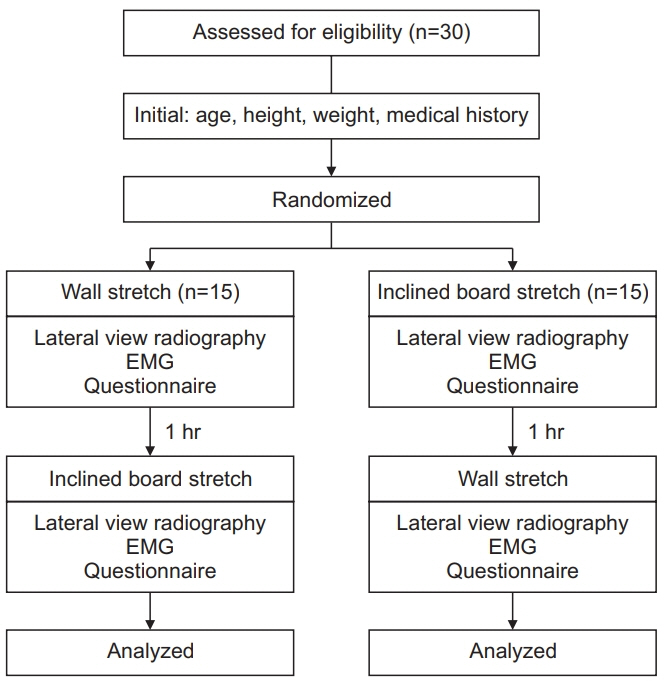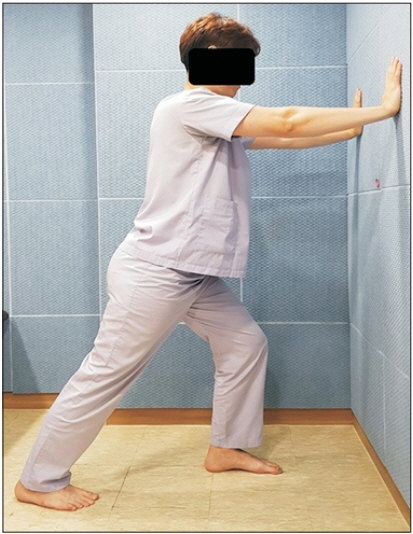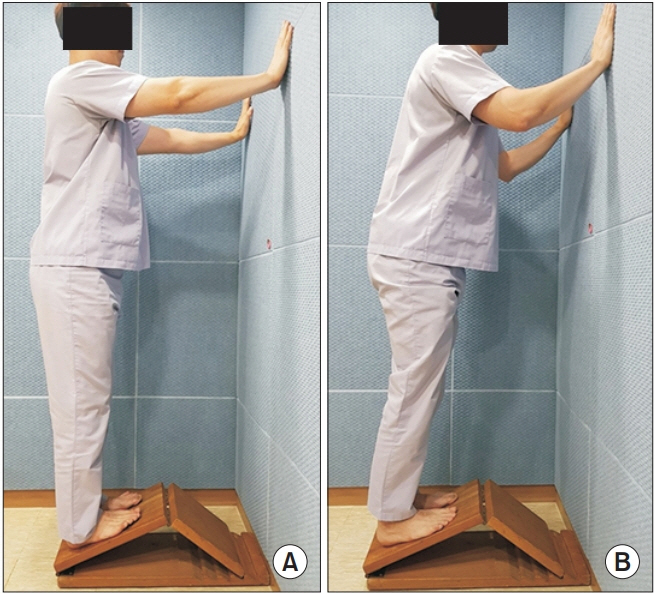Ann Rehabil Med.
2020 Apr;44(2):125-130. 10.5535/arm.2020.44.2.125.
Comparison of Two Static Stretching Techniques for the Triceps Surae in Healthy Individuals: Wall and Inclined Board Stretchings
- Affiliations
-
- 1Department of Rehabilitation Medicine, Konkuk University Chungju Hospital, Chungju, Korea
- 2Department of Rehabilitation Medicine, Gil Medical Center, Gachon University College of Medicine, Incheon, Korea
- KMID: 2501056
- DOI: http://doi.org/10.5535/arm.2020.44.2.125
Abstract
Objective
To compare the effectiveness of static stretching techniques for correcting the tightness of the triceps surae.
Methods
In this observational, cross-sectional study, participants (30 healthy volunteers) completed 10 repetitions of each stretching exercise, holding each stretch for 10 seconds, with a 1-minute rest period between repetitionsand a 1-hour rest period between the two stretching techniques, namely, wall and inclined board stretchings. The length of the triceps surae and range of ankle dorsiflexion were measured on lateral view radiographs. The muscle activity during the stretch was measured using quantified surface electromyography of the lateral gastrocnemius. The subjective stretching sensation was evaluated using the visual analog scale.
Results
Both stretching techniques showed statistical differences in all the parameters. Stretching on an inclined board yielded a greater increase in the triceps surae length than did wall stretching (mean difference, 0.72; p=0.02). The range of ankle dorsiflexion was higher with inclined board stretching than with wall stretching (mean difference, 2.57; p=0.03). The mean muscle activity was significantly lower withinclined board stretching than with wall stretching (mean difference, 53.72; p<0.01). The visual analog scale score was higher with inclined board stretching than with wall stretching (mean difference, 2.07; p<0.01).
Conclusion
In this study, inclined board stretching was more effective than wall stretching for correcting tightness of the triceps surae. Therefore, inclined board stretching should be encouraged for the triceps surae.
Keyword
Figure
Reference
-
1. Malhotra K, Chan O, Cullen S, Welck M, Goldberg AJ, Cullen N, et al. Prevalence of isolated gastrocnemius tightness in patients with foot and ankle pathology: a population-based study. Bone Joint J. 2018; 100B:945–52.2. Radford JA, Burns J, Buchbinder R, Landorf KB, Cook C. Does stretching increase ankle dorsiflexion range of motion? A systematic review. Br J Sports Med. 2006; 40:870–5.3. Baumbach SF, Braunstein M, Regauer M, Bocker W, Polzer H. Diagnosis of Musculus Gastrocnemius Tightness - Key Factors for the Clinical Examination. J Vis Exp. 2016; (113):53446.
Article4. Jeon IC, Kwon OY, Yi CH, Cynn HS, Hwang UJ. Ankledorsiflexion range of motion after ankle self-stretching using a strap. J Athl Train. 2015; 50:1226–32.
Article5. Macklin K, Healy A, Chockalingam N. The effect of calf muscle stretching exercises on ankle joint dorsiflexion and dynamic foot pressures, force and related temporal parameters. Foot (Edinb). 2012; 22:10–7.
Article6. Thacker SB, Gilchrist J, Stroup DF, Kimsey CD Jr. The impact of stretching on sports injury risk: a systematic review of the literature. Med Sci Sports Exerc. 2004; 36:371–8.
Article7. Peters JA, Zwerver J, Diercks RL, Elferink-Gemser MT, van den Akker-Scheek I. Preventive interventions for tendinopathy: A systematic review. J Sci Med Sport. 2016; 19:205–11.
Article8. Youdas JW, Krause DA, Egan KS, Therneau TM, Laskowski ER. The effect of static stretching of the calf muscle-tendon unit on active ankle dorsiflexion range of motion. J Orthop Sports Phys Ther. 2003; 33:408–17.
Article9. Kuzma SA, McNeil SP. A comparison of prostretch versus incline board stretching on active ankle dorsiflexion range of motion. UWL J Undergrad Res. 2005; 8:1–6.10. DiGiovanni BF, Nawoczenski DA, Lintal ME, Moore EA, Murray JC, Wilding GE, et al. Tissue-specific plantar fascia-stretching exercise enhances outcomes in patients with chronic heel pain: a prospective, randomized study. J Bone Joint Surg Am. 2003; 85:1270–7.11. Mizuno T, Matsumoto M, Umemura Y. Viscoelasticity of the muscle-tendon unit is returned more rapidly than range of motion after stretching. Scand J Med Sci Sports. 2013; 23:23–30.
Article12. Russell JA, Shave RM, Kruse DW, Nevill AM, Koutedakis Y, Wyon MA. Is goniometry suitable for measuring ankle range of motion in female ballet dancers? An initial comparison with radiographic measurement. Foot Ankle Spec. 2011; 4:151–6.
Article13. Hermens HJ, Freriks B, Disselhorst-Klug C, Rau G. Development of recommendations for SEMG sensors and sensor placement procedures. J Electromyogr Kinesiol. 2000; 10:361–74.
Article14. Reid D, McNair PJ, Johnson S, Potts G, Witvrouw E, Mahieu N. Electromyographic analysis of an eccentric calf muscle exercise in persons with and without Achilles tendinopathy. Phys Ther Sport. 2012; 13:150–5.
Article15. Min BC, Kim JH, Jeon KJ, Lee DH, Kim JS. EMG fatigue comparative study of stair ascending and descending. In : Proceedings of the Society of Korea Industrial and Systems Engineering Spring Conference; 2006 May; p. 234–7.16. Gajdosik RL, Allred JD, Gabbert HL, Sonsteng BA. A stretching program increases the dynamic passive length and passive resistive properties of the calf muscle-tendon unit of unconditioned younger women. Eur J Appl Physiol. 2007; 99:449–54.
Article17. Foure A, Nordez A, Cornu C. Effects of eccentric training on mechanical properties of the plantar flexor muscle-tendon complex. J Appl Physiol (1985). 2013; 114:523–37.
- Full Text Links
- Actions
-
Cited
- CITED
-
- Close
- Share
- Similar articles
-
- Effect of Local Vibration on Triceps Surae Flexibility Compared to Static Stretching
- The Immediate Effects of Dynamic Stretching and Static Stretching Using a Wedge Board on the Balance Ability and Jump Function of Healthy Adult
- Anatomical Locations of the Motor Points of the Triceps Surae Muscles
- Immediately Effects of Static Stretching of the Ankle Plantar Flexor for 5 Minutes on Balance Control and Muscle Activity in Healthy Young Adults
- Comparison of Sit and Reach Test, Straight Leg Raise Test and Visual Analogue Scale When Applying Static Stretching and Mulligan's Two Leg Rotation in Young Adults with Hamstring Shortness





